Between 28 and 31 May 2018 the Department of Languages & Intercultural Studies (LINCS) is hosting the 2018 General Assembly and Conference of CIUTI, the Conférence internationale permanente d’instituts universitaires de traducteurs et interprètes, the oldest and most prestigious international association of university institutes with translation and interpretation programmes in the world. LINCS is a long-standing member of CIUTI and one of only three UK members. The theme of the Conference is Translation and interpreting in an era of demographic and technological change. In addition to CIUTI delegates from around the world, LINCS will also be hosting a visit by Mrs Florika Fink-Hooijer, the Head of the Directorate General for Interpretation at the European Commission, who is coming to speak to colleagues involved with the delivery of conference interpreting programmes and to view the excellent interpreting facilities available to LINCS students.
Category Archives: Research
Deaf Artists commissioned on Translating the Deaf Self project
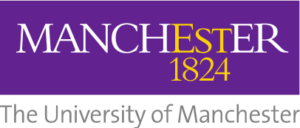
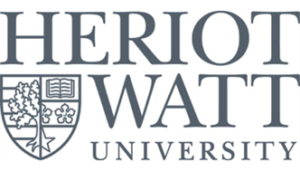
Using an innovative approach to re-interpret Deaf Studies and Interpreting research through art, 3 Deaf sign language using artists have been commissioned through Arts & Humanities Research Council (AHRC) Follow-on Funding to ‘translate’ the findings of the Translating the Deaf Self project that was initially funded through an AHRC Research Innovation Grant. The original project investigated deaf sign language users’ experiences of being known through translation the representation of deaf people through sign language interpreters and the potential impact on well being. This project explores the findings from that project through artistic exploration and transformation in the visual arts as a means of engaging more deaf people and communities with these ideas.
This interdisciplinary project is being led jointly by a deaf-hearing research team from the Social Research with Deaf People group in the School of Health Sciences at the University of Manchester and the Centre for Translation & Interpreting Studies in the Department of Languages & Intercultural Studies at Heriot-Watt University.
The team are working collaboratively with Deaf Explorer – an artist agency supporting Deaf creatives – to support artists-in-residence in Deaf community organisations, including Deaf Action in Edinburgh, DeafPLUS in London, Manchester Deaf Centre and the Royal Association of the Deaf in Romford.
Three professional artists, and one artist intern, will spend a period of time in each organisation where they will be given the time, space and resources to delve into the issues reported in the preceding Translating the Deaf Self project with local Deaf people and to inform their artistic inspirations. Other arts based workshops will happen in further locations.
This is a community-participatory project that not only involves local deaf communities but also offers the opportunity for deaf artist capacity building through the recruitment of a new deaf artist to shadow one of the professional artists as an intern.
An exhibition of the artwork will take place in September 2018, and community responses to the art will be gathered in order to further explore the extended concept of Translated Deaf Selves.
INTRODUCING THE ARTISTS
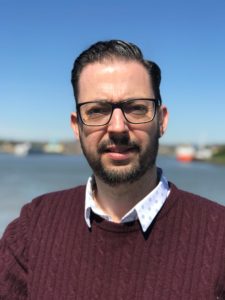
Christopher Sacre will be based at Deaf Action. His work involves exploring the flow, boundaries and the shape of humanity and human populations, the inclusion and exclusion and how some humans move through the world differently to the rest.

Rubbena Aurangzeb-Tariq will be based at Deaf Plus and her installations and paintings explore how we collect our feelings and thoughts within ourselves and how we learn to contain them within our own personal space and cultural boundaries.
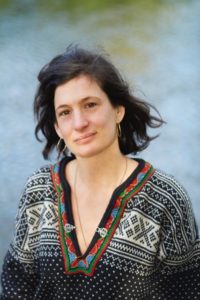
Louise Stern will be based at the Royal Association of the Deaf and has produced visual arts, films, and literature that work around ideas of language, communication and isolation.

Ruaridh Lever-Hogg recently graduated with a Masters in Fine Art from the University of Dundee and will be involved as an intern.. In his artwork he explores emotional responses to place, events, form or object.
Want to know more?
![]() @UoMSORD @HW_CTISS @deafexplorer
@UoMSORD @HW_CTISS @deafexplorer
Search the hashtag #ArtviaTDS on all social media platforms (Instagram, Twitter and Facebook.) The artists and research team will be using this hashtag to post about this project and its progression!
For more information about the preceding Translating the Deaf Self research project, follow the blog posts, linked below (BSL versions also available on these websites):
2 October 2014 [Uni of Manchester] Translating the Deaf Self: understanding the impact of mediation
8 March 2016 [LINCS] Translating the Deaf Self: An update
30 Aug 2016 [LINCS] The Translating the Deaf Self project: Where are we now?
13 Jan 2017 [LINCS] The Translating the Deaf Self project: Wrapping up and what’s next?
This project is funded by a grant from the Arts and Humanities Research Council (Ref: AH/R003750/1)
For further information contact alys.young@manchester.ac.uk or j.napier@hw.ac.uk
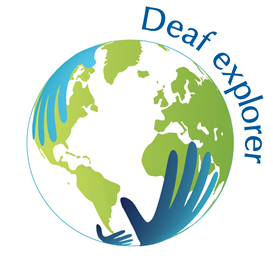
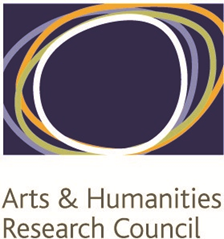
Links to project team & partners:
https://www.bmh.manchester.ac.uk/research/nursing-groups/social-research-with-deaf-people/
http://www.manchesterdeafcentre.com
Links to deaf artists:
http://www.christophersacre.com/website/Home.html
https://en.wikipedia.org/wiki/Louise_Stern
http://www.tenartists.co.uk/artists/ruaridh
LINCS post-graduate researchers hold first symposium
Wednesday 25th April was the occasion of the first LINCS PGR Symposium. Over the course of the day, nine post-graduates presented papers to an audience of their peers, lecturers and professors from within the department. Reactions were universally positive, succinctly summarised by this tweet by @HW_LifeinLINCS:
Incredibly insightful and thought-provoking presentations.
Contributors ranged from those who had only recently started their PhD journey, to two who are busy writing up their theses with a view to submitting the finished works at the end of the summer. Research interests were grouped in four panels: translation, language and identity, sign language interpreting, and spoken language interpreting. Sites of research ranged from the Heriot-Watt University classroom to Faroese fish-processing factories, by way of theatres and mental health clinics, court-rooms and police custody suites, Google translate and the Galician community in London.
The papers delivered on the day were as follows:
Paola Ruffo: Literary Translators’ perceptions of their role and attitudes towards technology in contemporary society
Nga-Ki Mavis Ho: Academic translation from English into Chinese: Increasing awareness and handling of academic rhetoric by the introduction of the Graduation system
Elisabeth Holm: New Speakers of Faroese and the Sociolinguistics of Labour Market Access and Participation
Michael Richardson: Deaf and hearing theatre – creating an intercultural third space
Alex Dayan- Fernandez: Reinventing transnational networks: Contemporary language activism, linguistic ideologies, and cultural identity (re)constructions of the Galician diaspora in London
Emmy Kauling: “He’s a professional *something*” – Co-constructing professional identities through interpreted professional discourse.
Christopher Tester: Perceptions of the Role and Function of Deaf Interpreters Working in the Court of Law
Rob Skinner: Ap-proximately there: Video-mediated interpreting services at Police Scotland
Natalia Rodríguez Vincente: Rapport management in interpreter-mediated mental healthcare encounters: a shared responsibility?
Inevitably you can find more information about all these papers on Twitter – post-graduates can be active tweeters! Look for #HWPGRsymp18.
The value of the day lay not only in the opportunity for students to present their papers, but also in the responses those papers stimulated. Each presentation was followed by lively questioning and debate and the day was notable for the supportive and collaborative atmosphere created by all the participants. Post-graduates were inspired to think about new aspects of their work, and everybody developed greater insight into the breadth of interesting research that is being carried out across the department. Importantly, we were able to make links between individual research projects that will lead to further discussion where interests or methods overlap.
In summary, the PGR Symposium was an important and successful experience for all involved. There have already been calls for it to become a regular feature of the LINCS calendar, perhaps twice a year, to ensure all PGRs have a chance to present their work in the safe environment that the symposium offers. Personally, I hope not to be here for the next one (I’m one of those working towards submission of my thesis in a few months), but I very much look forward to seeing my own Twitter feed filled by photographs and summaries of the research undertaken by future cohorts of LINCS PGRs.
Michael Richardson
LINCS PGR Representative
Award for human rights scholarship for deaf juror research
I am excited to provide an update on a research project that I have been involved with for the last ten years.
The project has focussed on deaf jurors, and whether deaf people can serve as jury members.
I initiated the project with law academic, David Spencer, and we examined whether deaf people could comprehend the jury instructions from a judge in a courtroom through a sign language interpreter. We were interested in whether deaf people could comprehend the message indirectly through an interpreter, as compared to hearing people who listened directly in English. We found that in comparison, both groups could comprehend equally, and misunderstood the same (small) level of information, which proved that deaf people are not disadvantaged by accessing the information through an interpreter.
In addition, we have also interviewed lawyers and judges who had experience of working with deaf jurors, members of the deaf community, and sign language interpreters, to elicit their opinions as to whether deaf people could carry out jury duties. The majority of the respondents confirmed that they advocate for deaf people to serve as jurors, and in fact it is their human right, as recognised in the United States where deaf people have been serving as jurors in various states since 1979.
Along with researcher Debra Russell, I visited the city of Rochester in the US, to observe the a jury selection (empanelment), and the process of a deaf person participating in that process through an interpreter.
In addition, with a team of researchers funded by the Australian Research Council, including David Spencer, Sandra Hale and Mehera San Roque, we further investigated this topic and conducted a mock trial where we invited actors to re-enact an actual trial that had previously taken place. We observed how a deaf juror participated in the trial with two interpreters in the courtroom and then how all the jurors conferred in private their deliberations on the case before delivering their verdict. We analysed the video recordings we had made of the whole trial. The main obstacle that many countries have presented as a dilemma was the fact that only twelve jury members are permitted in the jury room (or fifteen members according to the country’s law). Bringing in interpreters would exceed that limit and that was not deemed acceptable as it may impeach a trial and compromise the confidentiality of the jury deliberations. Our research showed otherwise – that the presence of the interpreters did not have any impact on the deliberations and there were no negative effects on the trial. Members of the jury who we interviewed confirmed that it was fine having the deaf jury member with his interpreters, and that there was no negative influence. They affirmed that deaf people can participate in jury service.
We have published several articles about our findings, one of which was published in the Australian Human Rights Journal, where we stated that if deaf people are not offered the opportunity to serve as jury members, it would breach of their human rights with respect to their right to participate and contribute to society as an equal, especially in justice.
To our delight, that publication has been selected for the Australian Human Rights Journal inaugural Andrea Durbach Award for Human Rights Scholarship. The publication has been recognised as an important one which advocates for the human rights of deaf people. We are very proud to receive the award.
We have worked together with the British Deaf Association, Deaf Australia and the World Federation of the Deaf to promote the impact of this research. The award includes prize money of $1000 Australia dollars. We have decided to donate the prize money to Deaf Australia’s fundraising website Jury Rights for All, which seeks to raise money to fund the campaign to allow deaf and disabled people to participate as jury members. We hope that the donation will support their work.
Initial translation from International Sign into English by EUMASLI students Tessa Heldens (Netherlands) and Ramon Woolfe (UK)
Making an Impact
For the last two and a half years I have been researching the participation of Deaf people in theatre. With only a few months remaining, I am currently writing up my PhD thesis, wondering what I am doing – and often, why I am doing it. Of course, working bilingually in English and British Sign Language with a mixed group of Deaf and hearing actors for a week last summer was great fun. Finding out what audiences thought about the finished work was fascinating. Turning it all into 80,000 words of highly academic but readable prose? Well, let’s just say, the 65,000 words I still need to write aren’t coming easily. I can’t yet see the light at the end of the tunnel.
Fortunately, my PhD journey started well, and I am regularly reminded of the benefit of academic research by emails I receive from people who have changed their practice as a result of my work. It all started in my first year as a postgraduate, when I was invited by a theatre to conduct a small study for them, attempting to find out why the numbers of Deaf spectators were lower than expected for Sign Language Interpreted Performances (SLIPs).
SLIPs are performances of spoken language theatre that are simultaneously translated into sign language, usually by a single interpreter standing in the downstage corner of the stage at some distance from the actors. They are the typical method currently employed to encourage Deaf sign language users to attend mainstream theatres.
In my research I interviewed Deaf and hearing audience members, as well as a theatre interpreter, and staff responsible for access in the theatre. The results suggest that SLIPs do not provide Deaf spectators with an experience equivalent to that of hearing audience members. Interpreters are inadequately trained and usually given insufficient resources to prepare for a SLIP. Theatre companies are often uninterested in, if not opposed to, the presence of the interpreter on stage, and insist on her spatial separation from the main production, making it impossible for spectators to follow the show and the translation at the same time. Theatre venues, despite promoting a performance in sign language, often do not use sign language in their marketing materials or in front of house facilities. As a result they do not present a welcoming image to the very people they are trying to attract. Understandably my Deaf participants had little positive to say about the effectiveness of SLIPs in providing access.
The aim of a preparatory study such as this within the PhD process is to give an opportunity for postgraduate researchers to develop and refine their research skills; and for academic staff to ascertain whether their PhD student is ready to progress to the full-scale study on which their thesis will be built. My work on SLIPs, however, has gone far beyond this.
My research was the first to ask Deaf people their views on SLIPs, and there has been significant interest in my results from the academic community. I have spoken at several conferences in the UK and Europe on the challenges of delivering SLIPs. Most recently I presented my thoughts on the need to establish a separate professional speciality of performance interpreting to support the development of quality provision of SLIPs, at the Third International Conference on Interpreting Quality in Granada (http://qinv.ugr.es/iciq3-en.htm). I have also written articles based on my research. A paper on interpreting and theatre translation was published in 2017 in the online journal TranscUlturAl (https://journals.library.ualberta.ca/tc/index.php/TC/article/view/29265). A second paper, ‘The Sign Language Interpreted Performance: A Failure of Access Provision for Deaf Spectators ‘ will be published in March in the journal Theatre Topics (volume 28 (1), pp. 63-74).
Whilst spreading awareness of my work within the academic community is a desirable part of the PhD journey, I am also pleased that my research is having impact in the real world. I have been invited to speak at events aimed at cultural managers, theatre practitioners and interpreters throughout the UK: at the South Bank Centre in London with Deafinitely Theatre; in Ipswich with the Pacitti Company; at Manchester Art Gallery for the Greater Manchester Cultural Group for Deaf People; and as part of the Edinburgh Festival Fringe.
Each of these events is part of the work in progress towards adequate access to cultural events for Deaf people, as is my ongoing contribution to a working group in Edinburgh that aims to develop opportunities for Deaf-led arts and cultural activities.
More tangible results have followed from discussions with individual practitioners. Zane Hema, an interpreter trainer based in Australia, is using my ideas about performance interpreting in Continuous Professional Development sessions that he leads. ZooCo (https://wearezooco.co.uk/), a small touring company that works to make theatre accessible to diverse audiences, is using my research to inform their thinking about how to engage Deaf audiences. In Gloucester, the Strike a Light Festival took on a number of the recommendations that I made, including having staff Front of House who could greet Deaf patrons in sign language; and keeping seats for Deaf spectators at SLIPs that give the best possible view of interpreter and stage. Previously they had not attracted any Deaf people at all; having made these changes, they estimate that approximately 5% of their audience during their 2017 festival was Deaf. In the March 2018 festival they will also use the Difference Engine, a piece of technology that streams captions onto an individual’s smart phone or tablet, for their production of Lucy J Skilbeck’s Joan (https://www.strikealightfestival.org.uk/events/joan/).
As I write this, I am in the middle of slowly redrafting the first half of my literature review, and thematically coding the seemingly endless hours of video data that I generated in my main research project last year. Nevertheless, I am encouraged by the fact that the work I did in the first year of my PhD is already having an impact, not only in universities, but also in the real world of cultural provision. My research is contributing to an improvement in the lives of Deaf people, at least in the arts. And that, I remember, is why I am doing it.
Borderland identities

“Wie, Sie … äh… du weißt nicht wie Snapchat geht?” Three pairs of eyes fix me in complete disbelief. A part of me wants the floor of the rehearsal room to open wide and swallow me there and then. For the third time in less than two hours I am pleading age-related ignorance of this or that social media platform. And it is only day 1 of the workshop.
Catching up with 21st-century culture was an interesting by-product of my work with Čojč Theaternetzwerk Böhmen Bayern (http://cojc.eu/cs/), a Czech-German theatre network in 2017. The network organises bilingual theatre projects on both sides of the border, and I joined last year’s main project, Like/Hate, as a participant observer. For two weeks in August and September, Like/Hate brought together 20 young people aged 14 to 27 living Bavaria and Bohemia to create a theatrical performance centering on the influence of social networks on our thinking, behaviour, and the way we present ourselves to the world. My main reason for observing the project had less to do with the question how we conceive of performing the self in and through social media than with an interest in the participants’ real-life communication and interactions – with each other and with the audience.
In many bilingual youth projects along the German borders, pooling linguistic resources is considered one of the main strategies for facilitating intercultural dialogue and fostering cross-border relationships unencumbered (or at least less encumbered) by the baggage of historical differences between the Germans and their neighbours. Čojč projects are no exception but they go one step further in that they aim to create performances which are accessible to monolingual speakers of Czech and German alike by using a hybrid of Czech and German, Čojč, on stage. The network motto provides a good example of how this can work: ‘Mit divadlem theater hýbat grenzen hranicemi bewegen’. The word Čojč itself is a blend of from the Czech word for the Czech language, Česky, and the use of Czech spelling for the word [d]eutsch – [d]ojč, and in some senses, Čojč (the language) is the verbal manifestation of a strong sense of a distinct regional identity grounded in the historical and cultural particularities of the Bavarian-Bohemian border region that pervades the network.
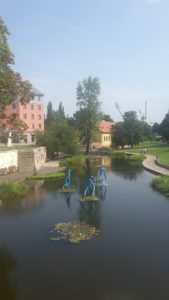
The city of Plzeň
So how does the Čojč network use language(s) to express, negotiate and potentially transform (individual) identities? How do workshop participants communicate with each other? Which language do they use, when, and why? What are the effects of using a hybrid language on the audience? In other words, how is regional identity performed and how is it changed in and through performance? And how do such performances integrate into contemporary discourses about the role of regions in responding to societal challenges within the EU? These were just some the questions that guided my observation of the devising process and the interviews I conducted with participants and network members. The larger framework for this research is the Horizon2020-funded project Critical Heritages: performing and representing identities in Europe (CoHERE) (https://research.ncl.ac.uk/cohere/) which investigates the socio-political and cultural significance of European heritages and their role in developing communitarian identities. My work with Čojč Theaternetzwerk Böhmen Bayern forms a case study within the project work package led by Heriot-Watt and the Latvian Academy of Culture focusing on cultural forms and expressions of identity in Europe (PI: Prof Ullrich Kockel).
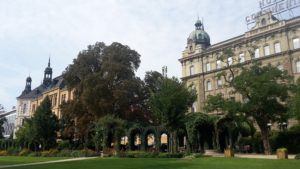
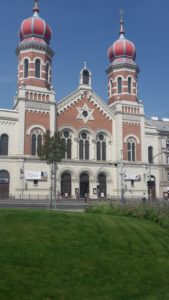
Landmarks of Plzeň
Data analysis is still ongoing, but some main themes are already emerging. The first is the importance of liminal spaces in which borders – linguistic, cultural, political – and dichotomies are temporarily suspended a and in which the question of the contours of a particular cross-border identity can be explored and negotiated. The second concerns language use. For Like/Hate, some ground rules for communication were assigned top-down from the bilingual project leader team; more frequently, however, participants made their own decisions about how to communicate effectively with each other and how to produce theatrical material that is accessible to monolingual speakers of Czech and German respectively. Bilingual cooperation relied quite strongly on translation in the devising and rehearsal process. Within that process, translation was conceived of from the outset as a collaborative activity – and a collaborative responsibility. While translation accountability was sometimes regarded as an unwanted or uncomfortable responsibility by the participants, it also holds the potential to become a vehicle for authority in the co-creative process. Moreover, the communication choices made by the participants clearly went beyond pragmatic concerns: they frequently reflected existing linguistic asymmetries. Or, in other words, German dominated the rehearsal room. These initial findings about communication choices suggest interesting parallels with other bilingual theatre workshops, such as Michael Richardson’s (Heriot-Watt University) investigations into BSL-English theatre. These will be presented as part of a comparative study at the upcoming conference of the International Association for Translation and Intercultural Studies (IATIS) in Hong Kong:
Pfeiffer, K., and Wurm, S., ‘(Un)Performing Barriers: A comparative study of bilingual theatre in two inter-cultural spaces’, paper to be presented at 6th IATIS Conference, 3-6 July 2018, Hong Kong
Curious about Čojč and Like/Hate? Meet the participants and watch the project vlogs here: https://www.like-hate.com. Two of seven performances in Passau and Pilsen are also available as a livestream on the Čojč Land Network Facebook page https://www.facebook.com/cojcface/.
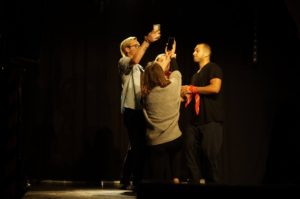
DESIGNS project update – December 2017

By Audrey Cameron & Jemina Napier
In this blogpost, Audrey Cameron and Jemina Napier explain what has been happening so far on the DESIGNS project (promoting access in employment for deaf people), since the last update in November 2017.
Audrey has just finished interviewing nearly 40 deaf sign language users on their experiences of employment and Jemina is interviewing sign language interpreters on their experiences of working with deaf people in their workplace. We will start analysing the data in the new year.
We will also be looking into interviewing employers in early 2018 for their perspective on deaf people in employment. We are delighted to be working with a new project partner – Vercida. The company was previously known as ‘Diversity Jobs’ and they have a good network of contacts with numerous companies and employers across the UK. Vercida is keen to work with us to recruit employers for the DESIGNS project.

The next DESIGNS community event will be in Bruges, Belgium, in January 2018 and hosted by one of our project partners the European Union of the Deaf, where we will introduce the project to the local deaf community and local sign language interpreters.
We would like to thank all the deaf sign language users and sign language interpreters for participating in the project so far and sharing their employment experiences.
Here is the transcript of the BSL video:
Audrey: Hello!
Jemina: Hello!
Audrey: We’re here to talk to you about the latest on the Designs Project.
Jemina: I thought it would be nice to provide you with an update so you know what we’ve been up to. So, Audrey what have you been doing since you started working on the project in October, in the last two, almost three, months?
Audrey: Has it been two months? The time has gone really quickly. I’ve been interviewing deaf people who we’ve put in different groups according to their employment status, i.e. those already in employment, those who are looking for work and aren’t currently in employment, and people who are self-employed and/or run their own businesses. So it’s going really well; numbers wise, in total I have met with almost 40 people, which is good.
Jemina: Yes, that’s a lot…
Audrey: What about you, Jemina?
Jemina: For my part, I have been focusing on interpreters, obviously I’m an interpreter so I have been interviewing interpreters about their experiences working with deaf people in employment settings. This could interpreting at job interviews or actually in the workplace; I’m looking at any barriers they may have come across; how things have gone – both good and bad experiences. Audrey and I have been talking about this and it’ll be really interesting, as we will work through the data, to see the differences and similarities from two different perspectives – how interpreters perceive things and, in your case, Audrey, deaf people’s views. It’s going to be really fascinating to see how they compare.
Audrey: Yes, it’ll be interesting. The next step will be to approach employers – we’ll be asking them what it is like for them working with deaf people, or if they don’t have any deaf employees, what they think about having deaf people working for them; we’re looking to start doing that in the new year.
Jemina: Yes. We’re also fortunate enough to have a new project partner, a company called ‘Vercida’. Vercida were previously known as ‘Diversity Jobs’; they’ve built up a really good network of contacts with numerous companies and employers across the UK. Vercida advises employers on how best to go about recruiting people with a range of disabilities and not just disability, also people who are gay or lesbian, so their focus is diversity in general in the workplace. They’re really keen to work with us on the Designs project and to look at ways to encourage employers to think about how they can recruit deaf people. So next year we’re going to be working closely with Vercida and they’ll be helping us make contact with employers, we’ll also maybe interview them and arranging visits to meet with employers. That will mean we’ll be able to explore things from three different perspectives – employers, deaf people and interpreters. We’re really pleased to have Vercida work with us and I know they’re really keen to partner with us – so that’s all very exciting and positive.
Audrey: I think we had thought it might be difficult for us to approach and find employers willing to participate in the project, but having Vercida helping us with that will make the process easier and we really are grateful for their support.
Jemina: Absolutely.
Audrey: Next year there will be more community events like the two events we had here this year; the first one was in Dublin, Ireland – that’s right Jemina, isn’t it?
Jemina: Yes, in Dublin at the start of 2017, then in Edinburgh in the summer…
Audrey: … and it’ll be in Bruges in Belgium in January 2018. Looking forward to going to meet people from both the local deaf community and locally based interpreters in Belgium.
Jemina: Anyway, we’ll let you know when we have anything new to share with you, probably sometime in the new year when we’ll be due a 6 months update on the project, so that’s us….
Audrey: We do both want to thank you for participating in the Designs Project and for sharing your stories – your involvement is hugely appreciated
Jemina: Yes, a big thank you all the deaf people and interpreters who have participated!
***
Reporting from 14th ETMU Days conference: ‘Race, Power and Mobilities’
Dr Katerina Strani led a working group on ‘Cross-cultural understandings of Race’ during the 14th ETMU Days conference themed Race, Power and Mobilities, which took place at the University of Jyväskylä, Finland on 26-27 October.
The working group was put together to examine cross-cultural understandings of race in the context of increased mobility and migration.
Minna Seikkula presented a paper on ‘The nexus between Anti-Racist Activists’ Conceptions of race/racism and migration’. Minna’s paper explored (dis)connections between racism and race/coloniality through an analysis of antiracist activists’ conceptions of racialized relations and practices in connection to migration. In Finland, as a part of the Nordic countries, speaking of racism often contains many paradoxes that are intensified by the current polarized political debate. For instance, Nordic self-perception is built on ideas of equality and democracy, while the eugenic pasts and their traces in the present are actively excluded from the grand narratives of the nation states. Race and racism are repeatedly seen relevant mainly or only in relation to migration, which can been seen to re-inforce the (false) image of white, homogeneous nation-states – yet, welfare state practices governing migration are often seen as neutral (or even anti-racist).
Minna’s paper compared the views of activists reacting to heightened presence of the extreme right, as well as those demonstrating solidarity to newly arrived migrants and those articulating Black, Brown and Muslim identities. In the analysis, the focus was on the question of how racialized oppression is connected to or disconnected from the continuum of coloniality, which reproduces a world divided between west and the rest through racialized borders. The analysis is based on interview data with 47 antiracist activists in Finland.
Next, Marta Padovan-Özdemir presented a paper written with Trine Øland on ‘Refugee Arrivals, Helping Hands and Hearts and Racialised Welfare Dynamics in Denmark, 1978-2016’. Marta and Trine’s abstract was as follows: “In the Summer of 2015, in all European welfare nation-states professionals, policy makers, administrators, and civil society organisations were in highest alert over the major refugee arrivals from Afghanistan, Syria, and the African continent. In Denmark, in particular, the government responded with stricter border controls and containment of refugees in temporary tent camps. Local administrative bodies and ngo’s contributed with panics about the managing of the new refugee groups. This state-of-alert is particularly interesting in a historical perspective of earlier Danish responses to the arrival of new refugee groups: The Afghans in the 2000s, the Bosnians in the 1990s, the Iranians in the early 1980s, the Vietnamese in the 1970s, the Jewish Poles in the late 1960s, the Hungarians in the 1950s, and not least, the Germans in 1945-46. The above-identified state-of-alert points to professional and civil confusion, disruption, and anxiety about not being able to manage a presumably new target group with the cultural repertoires already available. This state-of-alert crystallises welfare problematisations of the new target groups and becomes an occasion for the mobilisation of joint forces to manage and solve the imagined problems, thereby generating new tasks and needs for the helping hands and hearts.
This paper’s objective is to gain insight into continuities and breaks in re-presentations of the refugee, and on that background understand the welfare dynamic, which is mobilized in response to the arrival of new refugee groups.
The analysis builds upon critical studies of Danish welfare state developments and draws historical and analytical inspiration from Donzelot’s genealogies of the double pathologization inherent in welfare work. This is combined with Fanon’s underscoring of the racial order’s subtle expressions in postcolonial societies, which is supported by Said’s argument that re-presentation of the Other is the result of a willed human work.
Methodologically, the paper is designed as a historical-sociological documentary study of annual reports, newsletters, and consultations from Danish Refugee Council, Danish Red Cross and Association of Municipalities from the periods 1978-1980 (Vietnamese), 1992-1996 (Bosnians), and 2014-2016 (Syrian). The paper identifies two dominant re-presentations of the refugee as object of civil and public welfare work: the productive and the sick. Thus, the paper alludes to the racialisation of the welfare dynamic mobilized in response to refugees. A racialized welfare dynamic that is governed by an economic and pathological concern for the degeneration of society as well as of the individual.”
Finally, Katerina Strani presented her paper on ‘Exploring Cross-cultural Understandings on Race’. The concept of race, albeit controversial and disputed, is becoming more and more thematised in today’s multicultural societies, which are increasingly re-shaped by migration and changing demographics. These changes are bringing to the fore discussions on culture, belonging and otherness, with race being a central aspect of the latter. Starting from the premise that race is a social construct, Katerina’s paper looked at differences in the meaning, significance and difference in the construction of race and racialisation in different countries and cultures. The focus was on processes of exclusion and othering through racialisation and the hegemony of whiteness (cf Ahmed, 2007). It challenged the concepts of race and racism in the framework of migration nand mobility and urged the necessity to revisit these key concepts and seek definitions, clarifications and boundaries from people of colour themselves. The paper sought to establish a language to talk about race in a cross-cultural, changing and dynamic context without resorting to stereotypes, colourblindness or homogenisation of experiences.
The presentations were followed by a lively discussion on definitions, boundaries and ‘white saviour’ complex, which included two of the three keynote speakers of the conference, Nando Sigona and Tobias Hübinette. Working group participants are grateful for all comments and interest in our research!
The full conference programme and book of abstracts are available here: http://etmudays.etmu.fi/en/programme/
Bridging the Gap 5: Academics and community engagement
by Annelies Kusters, Jordan Fenlon and Jemina Napier
In the weekend of 25-26 November 2017, the fifth Bridging the Gap (BtG) conference was hosted at Heriot-Watt University. The aim of this conference series is to work towards bridging two gaps: first, the gap between academics (involved in Deaf Studies and sign language research) and deaf community members; and second, the gap between deaf and hearing academics within these fields. While the second gap triggered the organisation of the first BtG conference in 2014, the fifth iteration of the conference mostly focused on the gap between community members and academics. It was the first time that BtG lasted two days rather than one, and it attracted 120 participants: community members and academics hailing from all over the UK, the largest audience so far. The conference was heavily discussed on social media, particularly on Twitter (see #BTG5). The core organising committee consisted of Jemina Napier, Jordan Fenlon and Annelies Kusters, and others who have worked with us to plan the conference included Steve Emery, Dai O’Brien, Heather Mole and Emmy Kauling, and a number of student volunteers.

Annelies, Jemina and Jordan.
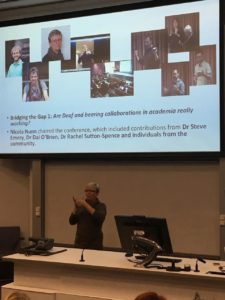
The conference started off with an introduction by Nicola Nunn, who organised the first BtG conference in Preston. She introduced the BtG series, emphasising that she was very happy to see that the conference was not an one-off and is now an established one in the British deaf conference landscape.

After Nicola, Jemina Napier took the stage to give the audience an impression of the kind of research and community work we are doing here at Heriot-Watt, where the BSL section has recently exponentially grown.
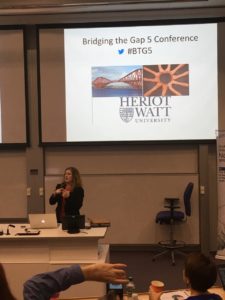
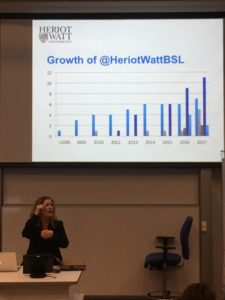
After opening the conference in this way, Hillary Third (Equality Unit, Scottish Government) and Frankie McLean (Deaf Action) gave a keynote presentation focusing on the implementation of the BSL (Scotland) Act. Hillary and Frankie explained that the aim of the Act is to make “Scotland the best place in the world for BSL users to live, work and visit”. The BSL National Plan for 2017-2023 contains 10 long-term goals and 70 actions in the next 3 years (covering early years and education training and work; health; culture and the arts; transport; justice and democracy) and a further set of actions will be published in 2020.
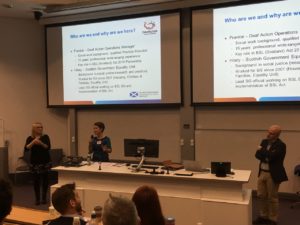
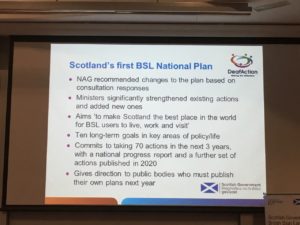
The Plan was constituted after extensive consultation: the National Advisory Group (NAG) has been successful in engaging large numbers of Scottish deaf people in the BSL Act. Not only was the NAG a great input for the Scottish Government, it also served as an instrument of empowerment. Several feeder NAGs such as a parent and youth NAG had input into the general NAG. An inspiring video was shown of 2 deaf teenagers who were involved in the youth NAG, talking about the valuable experience of being involved, since they “are the future”. The Act is a great example of working with and for a deaf community in order to create better life conditions for deaf people. This opening session was livestreamed (https://www.facebook.com/HWUBSL/).
When we were planning BtG5, we already knew during our first meeting that we didn’t want to organise a “typical” conference consisting of presentations to disseminate research findings. Indeed we thought that if we really wanted to work towards bridging a gap, we would need an interactive format, designed in order for people to be able to express a range of thoughts on the “gap” under discussion. So the three sessions that followed the keynote presentation were interactive.
The first interactive session was based on the TV programme Dragon’s Den, where entrepreneurs could pitch an idea for a panel of venture capitalists who would decide if they would fund the particular project or not. Jordan Fenlon facilitated this session at BTG5, asking: “what would you do if you had £2 million for a research project?”

The aim of this panel was for academics to learn about what kind of research deaf people find important and for the audience to get insight in the kind of thinking that’s involved in crafting a research proposal. Panelists for example pointed out the need to use buzzwords such as Thomas Lichy’s use of the word “hate crime”. They also pointed out that sometimes similar or related research has already happened (the dementia proposal); or that an idea (the deprivation project) had been previously pitched but not in a successful way. They said that a project such as the BSL corpus project would preserve old signs and regional variations, but a funder would require it to contribute to new academic theory, which is often a big challenge in applied projects. The idea that won the audience vote was Audrey Cameron’s: she suggested to work with Science Centres to give science teaching tessions to deaf children in BSL, and study how we think about science in sign language: a wonderful combination of doing exciting research in combination with direct benefits for deaf children.
A few academics and community activists/representatives came forward to pitch an idea that they had prepared in advance – the range of ideas covered:
BSL deprivation of deaf children (Tom Lichy)
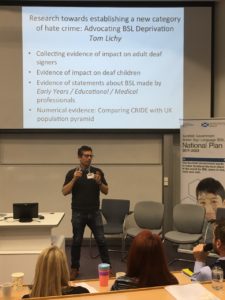
A Scottish BSL corpus project (Gary Quinn)
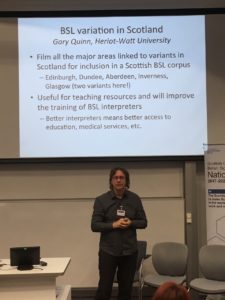
The Deaflympics 55 dB cut-off (Philip Gerrard)
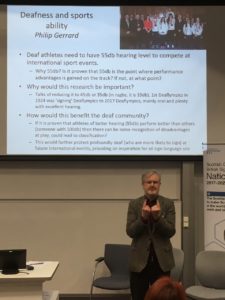
Sign language use in deaf people with dementia (Avril Hepner)
Mouthing in BSL (Adam Schembri)
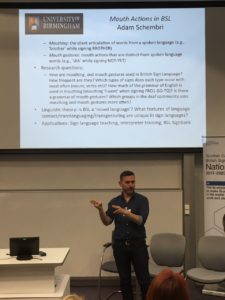
The impact of isolation on mental health (Herbert Klein)
And science learning in BSL (Audrey Cameron)
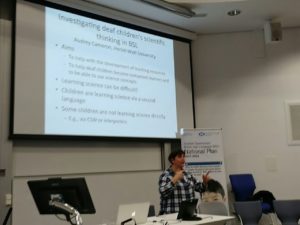
The panel consisted of academics and community representatives: Bencie Woll, Terry Riley, Graham Turner, Gordon Hay and Emma Ferguson-Coleman.
The second interactive session was called “Heriot Watt goes to Hollywood”, facilitated by Annelies Kusters and Gary Quinn, in which 6 short films were showed that were created by Heriot-Watt BSL section staff, PhD students, postdocs, BSL students and community members. The issues included: deaf people not learning about research findings after a project is concluded; having to sign epic consent forms in English; working with interpreters during research projects; the fact that participants often don’t want to admit when they need more clarificaton from academics; deaf people not knowing about Deaf Studies concepts but hearing interpreter students do, which can intimidate deaf people; deaf academics “leaving the community behind” to give presentations at international conferences and publish books. With the films, we tried to tackle issues in a humorous albeit serious way.
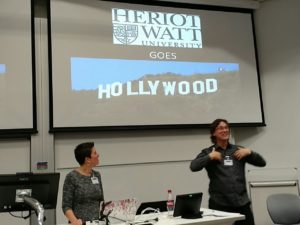
The Hollywood session led to lively discussions, and during the next session on the next day, a manifesto workshop was facilitated by Dai O’Brien, Jordan Fenlon and Annelies Kusters, in order to address the same issues with the aim of taking action in the shape of a manifesto. Everyone got involved, the discussions were recorded, and Dai, Jordan and Annelies will take this forward. They will summarise the videos and use the summary to create a first rough draft of the manifesto which will then be presented and further discussed during the next BtG conference.
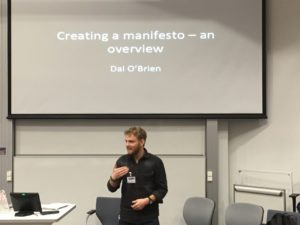
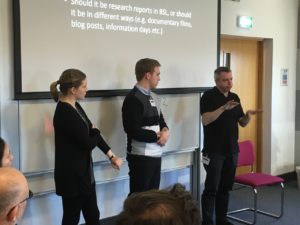
Some issues that were discussed during the Hollywood and manifesto sessions included: how are research findings made accessible and attractive for community members? In the case of participants who directly contributed to a research project, it is important to ask how they want access to the findings, eg. some might want a summary in BSL and others might want the full article in English. In case of the broader community there are a number of options. Who wants to watch a two hour signed report on academic topics? Other options include short signed summaries, documentary films, interactive websites and texts in plain English. It is important to make research meaningful and interesting, and that also often means that reports should be kept short. When giving live presentations, it’s important to consider where the event is hosted: a relaxing/safe space such as a trusted deaf club with a pint in the hand, or pizza in a chilled out place, fosters a very different kind of atmosphere than an university auditorium. An issue that surfaced multiple times during the conference is that researchers are increasingly proactive in trying to make their research accessible in BSL but members of the deaf community might not know the BSL report exists (such as the earlier mentioned dementia project). So, how can people learn what research is happening and where, and where can they find it? The clever use of hashtags and Facebook groups is one means but it was also suggested that a centralised website with a “research map” would be helpful.
It is not clear yet where the 2018 iteration of BtG will be organised. We hope that during the next BtG conference, we can discuss actual examples of “good practice” in research and community involvement and impact, and how these might inform the BtG Manifesto.
***
IPCITI returns to Heriot-Watt after 4 years!
by Paola Ruffo
The Centre for Translation and Interpreting Studies in Scotland (CTISS) at Heriot-Watt hosted the 13th International Postgraduate Conference in Translation and Interpreting (IPCITI), 9-10 November 2017
IPCITI is an annual postgraduate conference organised by students for students and it marks the consolidation of the collaboration between Dublin City University, Manchester University, the University of Edinburgh and Heriot-Watt University. Its main aims are to promote greater participation in Translation and Interpreting research and foster a supportive and intellectually stimulating environment where research and academia can be accessible in real terms.
This year, the IPCITI 2017 Organising Committee (Jafar Ahmad, Nga-Ki Mavis Ho, Lorraine MacDonald, Michael Richardson and Paola Ruffo) has worked hard to welcome delegates from all over the world to Heriot-Watt and create a diverse and enriching programme, which included meaningful contributions across all areas of Translation and Interpreting Studies.
The conference started with a workshop by Mr Ramon Inglada (CTISS, Heriot-Watt University) on ’CAT Tools: welcome to the cloud-based (r)evolution’ followed by Dr Ana-Frankenberg Garcia’s (University of Surrey) keynote on ‘The use of corpora in translation research’. Day two saw Interpreting research and practice join forces to discuss ‘Interpreting theory and practice in dialogue’ with a panel formed by Prof Graham Turner (CTISS, Heriot-Watt University), Prof Claudia Angelelli (CTISS, Heriot-Watt University), Mr Martin Gallagher (Police Scotland) and Ms Delphine Jaouen (NHS Scotland).
A variety of topics has been discussed by our international presenters over the course of these two days, covering diverse areas of T&I Studies such as translation and interpreting technologies, literary translation, interpreters’ training, British Sign Language interpreting, risk in translation, and news translation in relation to ideology and human rights.
To quote our Head of School, Prof Robert MacIntosh, who opened the conference: “We have a long heritage of Translation and Interpreting of which we are very proud” – this year’s successful and high-quality IPCITI drove that point home again.
You can follow The International Postgraduate Conference in Translation and Interpreting on twitter (@ipciti) and on the dedicated website www.ipciti.org.uk.
See you in Manchester for IPCITI 2018!
